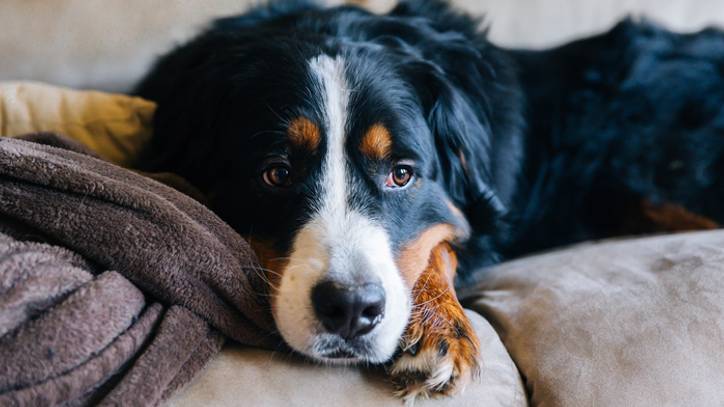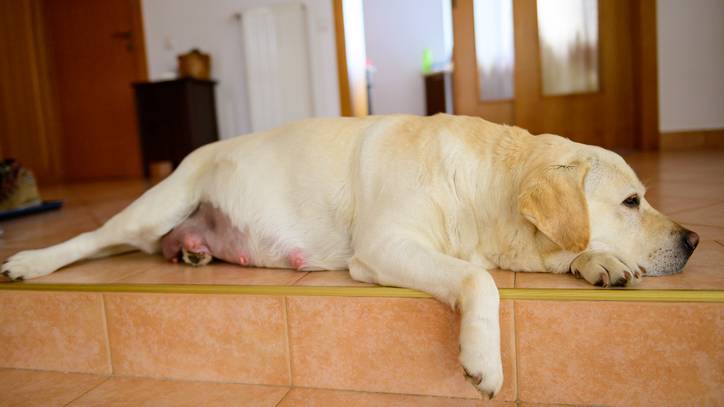Brucellosis in dogs: Vet's guide to symptoms and treatment
What is brucellosis in dogs? Is it dangerous to humans? And how can you get your dog tested?

Although historically there were no cases of brucellosis in dogs in the UK, cases have been on the rise in the last couple of years.
These cases are usually linked to dogs that have been imported from Europe, although within-UK transmission has also now occurred.
If you own a foreign rescue, work with dogs, or even just spend lots of time around dogs, you should read on for the latest on canine brucellosis.
What is brucellosis in dogs?
Brucellosis in dogs is a reproductive disease caused by the bacteria Brucella canis. Unless dogs are breeding, it’s not always obvious that they are infected, as the disease comes with few symptoms.
However, it’s still an important disease to be aware of because brucellosis can be transmitted to humans. Once a dog has brucellosis, it should be considered infected for life, and will always be a risk to others.
How do dogs get brucellosis?
The bacteria responsible for brucellosis is carried in the bodily fluids of infected dogs. While the main way that dogs catch brucellosis is by mating, it can also be carried in the saliva, blood, feces, and discharge from the eyes and nose, and dogs that ingest or even inhale the bacteria can become infected.
In addition, mothers can pass it to their pups in milk or in their uterus, although most female dogs that get brucellosis abort their litters.
Get the best advice, tips and top tech for your beloved Pets
Although brief contact with an infected dog is unlikely to cause a dog to become infected, sustained contact (such as sharing a home) can cause infection, as can spending time in an environment where an infectious dog has been.
How contagious is brucellosis?
Brucellosis is fairly contagious between dogs– although rare, it’s possible for dogs to catch brucellosis just by sniffing areas that an infected dog has passed urine or feces.
In most cases, neutered dogs without symptoms will be much less likely to pass on brucellosis to other dogs, while the highest risk comes from female dogs that are pregnant.
These dogs will usually abort their litter, and the abortive fluids are very contagious as they contain a lot of bacteria. Luckily, although brucellosis can infect humans it’s a lot harder for a human to catch it than a dog – the main risk is to people working closely with entire dogs, such as breeders and vets.

Can brucellosis affect both male and female dogs?
Yes, brucellosis affects both male and female dogs. It’s spread through mating and the bacteria is often found in seminal fluid in the male, or in vaginal discharge in the female.
What does brucellosis in dogs look like?
One of the problems with this disease is that many dogs won’t show symptoms of brucellosis. The most common symptoms are related to breeding – infertility, aborted litters, or weak puppies. Since most people aren’t actively breeding their dogs, they may not see signs of brucellosis in their dog at all.
Other symptoms of brucellosis in dogs include:
- Lethargy
- Decrease in activity
- Lameness
- Back pain
- Weight loss
- Eye problems
- Swollen testicles
- Swollen lymph nodes
However, it’s important to be aware that many dogs will not show symptoms, but are still capable of passing the disease on to other dogs or humans.
How long does it take for brucellosis symptoms to appear?
Once infected with brucellosis, a dog may show mild signs, but they can also remain asymptomatic. This means you can’t assume that just because you haven’t seen symptoms that your dog is negative.
If your dog has been imported, or has been in contact with an imported dog for sustained periods, it’s best to get them tested – especially if your dog is unneutered (entire).
How to test for brucellosis in dogs
So how do we go about testing for brucellosis? There are several tests available, none of which is perfect. The most accurate test involves your veterinarian sending a sample off to an external laboratory.
This will provide a fast answer if your dog has caught brucellosis. An in-clinic option (a little like the at-home covid tests) is available but won’t be stocked by all veterinary practices.
False positives are also possible with this test – all positives should be confirmed by sending a sample to the external lab. These tests may need to be repeated a few months later if your dog’s brucellosis exposure was recent, as the levels may still be undetectable.
If a dog is confirmed positive for brucellosis in the UK, the result must be reported to APHA, the government body in charge of animal health in the UK.

Treating brucellosis in dogs
Unfortunately, once a dog is infected with brucellosis, they’re considered infected for life. Treatment with antibiotics can reduce the symptoms and dogs appear to be recovering from brucellosis, but the dog will still be able to spread the disease.
Neutering dogs may also reduce the risk that the disease is spread but doesn’t remove it entirely. Infected dogs will not be allowed to contact other dogs and must not be taken to areas that other dogs frequently visit, which hugely limits their quality of life.
Do dogs with brucellosis need to be euthanised?
Although it seems extreme, especially when many dogs show no symptoms, the recommended course of action when a dog is diagnosed with brucellosis is euthanasia.
This is because there is no treatment that can prevent the dog being a danger to others, as well as to humans. For safety, limitations must then be placed on the dog – you will be asked to keep them away from other dogs, not to walk them in areas frequented by other dogs, and not to let them greet people.
Vets may not be able to hospitalise your dog or operate on them due to the risk to their staff and other patients. They are unlikely to be accepted by groomers or boarding kennels, and you’ll have to maintain excellent hygiene at home, washing your hands after touching your dog and not allowing them to spend time in the main rooms of the house.
For all these reasons, it’s generally considered kinder to euthanise a dog when it has been confirmed to be infected with brucellosis.

After graduating as a veterinarian from the University of Nottingham, Dr Joanna Woodnutt went on to practice companion animal medicine in the Midlands. She quickly developed a love of consulting and helping clients with medical problems such as dermatology, behavior and nutrition, and has written for countless online and print publications.
What about humans – how dangerous is brucellosis to me?
Brucella canis can spread to people, especially where numbers of shed bacteria are high. The greatest risk is to those who help dogs give birth or deal with lots of bodily fluids – such as vets and breeders.
However, anybody can catch brucellosis from a dog if they have sustained contact, especially if they are immunocompromised in any way. The symptoms include weight loss, headaches, fever, sweating, and back pain, and treatment is essential to prevent more serious problems occurring.
Summary
Brucellosis is thankfully still rare, but it’s on the increase. While it used to be entirely limited to dogs from abroad, it’s now passing from dog to dog within the UK.
If your dog was rescued from abroad or has had sustained contact with a dog from abroad it’s sensible to get them tested, especially if you’ve seen symptoms.
After graduating as a vet from the University of Nottingham in 2016, Dr. Joanna Woodnutt went on to practice companion animal medicine in the Midlands. She quickly developed a love of consulting and helping clients with medical problems such as dermatology, behavior and nutrition - anything that involved helping clients understand their pets better.
Jo started writing about pet health in 2017, realizing that it meant she could help even more pet parents. Since then, she has written for countless online and print publications and is a regular contributor for Edition Dog Magazine. Jo is the director of The Veterinary Content Company, which she founded in 2020. She is also the founder of Petlearnia, a platform that provides pet e-learning courses for pet parents.
Jo now lives in the Channel Islands with her husband Ian and terrier Pixie.
